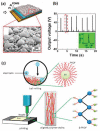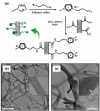Piezoelectric Materials for Energy Harvesting and Sensing Applications: Roadmap for Future Smart Materials
- PMID: 34254467
- PMCID: PMC8425885
- DOI: 10.1002/advs.202100864
Piezoelectric Materials for Energy Harvesting and Sensing Applications: Roadmap for Future Smart Materials
Abstract
Piezoelectric materials are widely referred to as "smart" materials because they can transduce mechanical pressure acting on them to electrical signals and vice versa. They are extensively utilized in harvesting mechanical energy from vibrations, human motion, mechanical loads, etc., and converting them into electrical energy for low power devices. Piezoelectric transduction offers high scalability, simple device designs, and high-power densities compared to electro-magnetic/static and triboelectric transducers. This review aims to give a holistic overview of recent developments in piezoelectric nanostructured materials, polymers, polymer nanocomposites, and piezoelectric films for implementation in energy harvesting. The progress in fabrication techniques, morphology, piezoelectric properties, energy harvesting performance, and underpinning fundamental mechanisms for each class of materials, including polymer nanocomposites using conducting, non-conducting, and hybrid fillers are discussed. The emergent application horizon of piezoelectric energy harvesters particularly for wireless devices and self-powered sensors is highlighted, and the current challenges and future prospects are critically discussed.
Keywords: energy harvesting; flexible devices; nanostructured materials; piezoelectric nanogenerator; polymer nanocomposites; polyvinylidene fluoride copolymers.
© 2021 The Authors. Advanced Science published by Wiley-VCH GmbH.
Conflict of interest statement
The authors declare no conflict of interest.
Figures

















































References
-
- Brown T. W., Bischof‐Niemz T., Blok K., Breyer C., Lund H., Mathiesen B. V., Renewable Sustainable Energy Rev. 2018, 92, 834.
-
- Paradiso J. A., Starner T., IEEE Pervasive Comput. 2005, 4, 18.
-
- Wei C., Jing X., Renewable Sustainable Energy Rev. 2017, 74, 1.
-
- Dewan A., Ay S. U., Karim M. N., Beyenal H., J. Power Sources 2014, 245, 129.
-
- Selvan K. V., Ali M. S. M., Renewable Sustainable Energy Rev. 2016, 54, 1035.
Publication types
MeSH terms
Substances
Grants and funding
LinkOut - more resources
Full Text Sources
